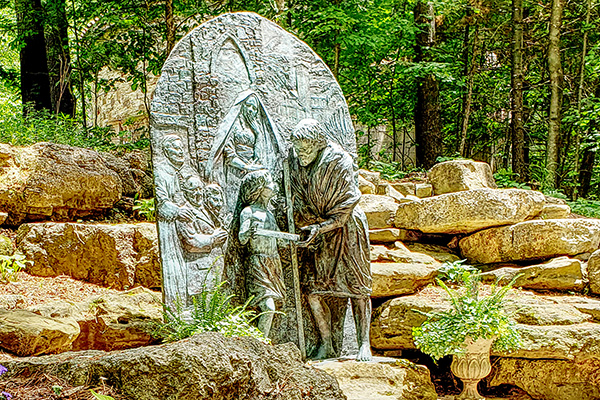Saint Joseph the Workman
Father Anthony Brankin, of the Archdiocese of Chicago, was commissioned by the Shrine of Our Lady of Guadalupe to create a unique bronze sculpture for
the outdoor Saint Joseph the Workman devotional area. This work, one of Father Brankin’s largest, took more than a year to conceptualize and create. The final finishing and addition of the fine patina was completed only days before the sculpture was delivered to the Shrine.
Originally conceived to be a bronze statue of Saint Joseph the Workman, the
commission decided it would be important to emphasize Saint Joseph’s foster fatherhood of Christ. The portrayal of Joseph was to include all of his qualities that enabled him to love, protect, and teach the boy Jesus as He grew in wisdom, age, and grace in Nazareth, as well as to portray those same qualities in Saint Joseph that modern fathers must aspire to, showing that Saint Joseph is both their patron and their model.

The bronze sculpture depicts a humble scene in Nazareth where the carpenter Joseph is shown teaching the boy Jesus how to work with wood. Jesus and Joseph glance at each other with peaceful looks—reflecting their quiet love and admiration for each other.
In order to establish some ironic drama, Jesus and Joseph have lashed together two planks of wood; they fashion a cross. Indeed, a premonition of the future seizes Mary; thus, she is seen gasping, putting her hand to her mouth. The bronze also shows Cardinal Burke [then Archbishop Burke] and Robert and Lucille Swing, who gave the original 70 acres of land to the Shrine. They are in prayer before Mary at the entrance to the home, turning their heads toward Jesus and Joseph in this quiet revelation of His most Merciful Death. Once again it is shown that devotion to Mary, as always, leads to her Son.
Unlike many artists, Father Brankin sculpts the heads first, in order to be constantly aware of the presence of the subject and to be inspired early on. Father Brankin likes to think that the figure he is sculpting is right there with him to guide his hand and to encourage his labors. When the sculptor steps back, “The eyes of the figures seem to cast just the right glance and the fingers curl just so!”
Then he adds, “Oh, that sends a cheer to my heart and a tear to my eye. And I know that I am as near to Heaven as I can be on earth.”
Father Brankin says God has given art to humanity so that we might be able to participate with and anticipate the inexpressible joys of Heaven.
Without words, and more surely than with them, art communicates God—His Knowability, His Essence, His Attributes.
The Saint Joseph the Workman devotional area was dedicated on September 21, 2007.